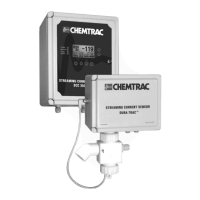Chemtrac Systems, Inc.
Page 43
verifications of the setpoint do not need to be performed daily, or even weekly,
unless there is a large, sudden change in turbidity or if a chemical that was not
being fed previously is going to be introduced (i.e. Potassium Permanganate).
Verifying the setpoint once every few weeks should be adequate for most
applications.
Maintenance Issues
To keep the monitor working properly, occasional maintenance will be
necessary. Cleaning only takes a few minutes to perform and is usually needed
once every 2 to 6 weeks (depending upon water quality conditions). An easy
test to see if the sensor needs to be cleaned is to first verify the reading has not
become “noisy” or “bouncy” and then make small changes in chemical feed to
make sure the sensor has not become unresponsive. As long as the monitor is
stable, responsive, and the response is no less than it has been noted in
previous response testing, the sensor does not need to be cleaned. If the
reading does appear to be less responsive or noisy, then record the amount of
response or noise (signal drift as measured in a one minute period) and then
remove the probe and piston for cleaning. First look to see if there is any
obvious buildup or solids in the probe or on the piston. Then, clean the probe
with a suitable cleaner (such as Comet/Ajax or Rover/CLR). Finally, rinse the
parts and install them back into the sensor. After allowing the sensor time to
stabilize, compare response and noise (if any) to previous results to verify the
cleaning did indeed improve response. If not, the piston and/or probe may need
to be replaced.
Eventually the moving parts of the monitor will wear. Most notably, the probe
and piston will wear the fastest and require replacement once every two years on
average. Once again, to determine if the probe and piston need to be replaced
simply make small chemical feed adjustments. If the probe is unresponsive and
cleaning does not improve the result, the probe and piston most likely need to be
replaced. Having a new set on hand to compare against is the best method of
determining if the parts need to be replaced. The motor in the monitor sensor
will also need replacing after 3 to 5 years of use. If the reading starts to become
slightly unstable, and cleaning or replacing the probe and piston does not
eliminate the unstable reading, check the shaft of the motor to see if it has
excessive movement. If so, replace the motor.
The Usefulness Of Spare Parts For Determining Probe/Piston Wear
If a spare probe and piston are on hand, it is suggested to keep these put aside
for comparing with the set in use and for replacing the old set when they become
worn. If the spare set is routinely swapped with the other set, then both sets will
experience wear. Always having a new, unused set on hand ensures you have a
point of reference for determining when your old set absolutely needs to be
replaced. For example, to compare the readings of your old probe and piston to
a new set, simple close the sample valve and drain all the sample out of the
probe block by removing the probe (you will also probably want to clean the
probe and piston at this time). Re-insert the probe and turn the outlet fitting 180
degrees so that it is pointing up. Next, pour a sample of untreated, raw water
into the probe block through the upturned outlet fitting. Allow the reading to
stabilize and record the reading and any amount of signal oscillation (bounce) as
seen in a one minute interval. Finally, remove the old probe and piston and
install the new set and pour in the raw water sample. Compare the readings of
the new probe and piston to the old set. If the readings from the old probe are

